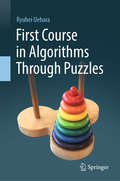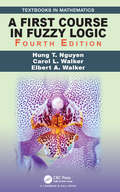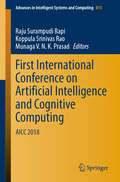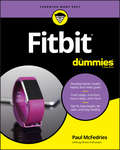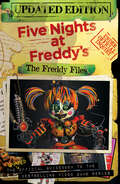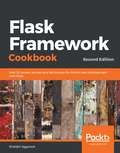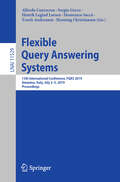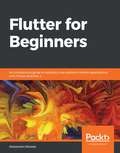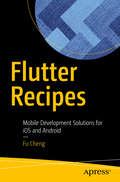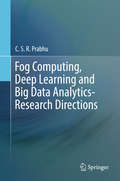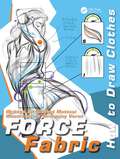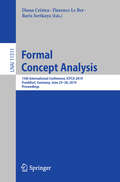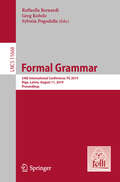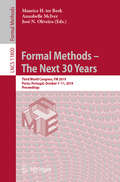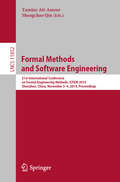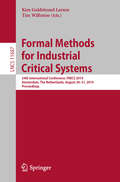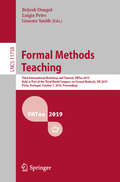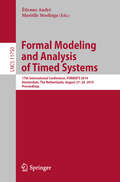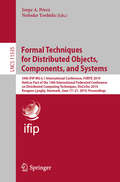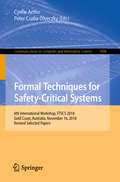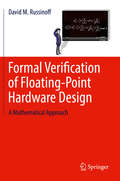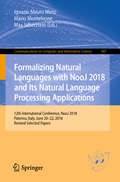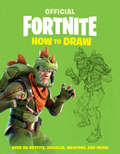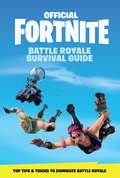- Table View
- List View
First Course in Algorithms Through Puzzles
by Ryuhei UeharaThis textbook introduces basic algorithms and explains their analytical methods. All algorithms and methods introduced in this book are well known and frequently used in real programs. Intended to be self-contained, the contents start with the basic models, and no prerequisite knowledge is required. This book is appropriate for undergraduate students in computer science, mathematics, and engineering as a textbook, and is also appropriate for self-study by beginners who are interested in the fascinating field of algorithms. More than 40 exercises are distributed throughout the text, and their difficulty levels are indicated. Solutions and comments for all the exercises are provided in the last chapter. These detailed solutions will enable readers to follow the author’s steps to solve problems and to gain a better understanding of the contents. Although details of the proofs and the analyses of algorithms are also provided, the mathematical descriptions in this book are not beyond the range of high school mathematics. Some famous real puzzles are also used to describe the algorithms. These puzzles are quite suitable for explaining the basic techniques of algorithms, which show how to solve these puzzles.
A First Course in Fuzzy Logic (Textbooks in Mathematics)
by Hung T. Nguyen Carol L. Walker Elbert A. Walker<p>A First Course in Fuzzy Logic, Fourth Edition is an expanded version of the successful third edition. It provides a comprehensive introduction to the theory and applications of fuzzy logic. <p>This popular text offers a firm mathematical basis for the calculus of fuzzy concepts necessary for designing intelligent systems and a solid background for readers to pursue further studies and real-world applications. <p>New in the Fourth Edition: <p> <li>Features new results on fuzzy sets of type-2 <li>Provides more information on copulas for modeling dependence structures <li>Includes quantum probability for uncertainty modeling in social sciences, especially in economics</li> <p>With its comprehensive updates, this new edition presents all the background necessary for students, instructors and professionals to begin using fuzzy logic in its many—applications in computer science, mathematics, statistics, and engineering. </p>
First International Conference on Artificial Intelligence and Cognitive Computing: Aicc 2018 (Advances In Intelligent Systems and Computing #815)
by Raju Surampudi Bapi Koppula Srinivas Rao Munaga V. PrasadThis book presents original research works by researchers, engineers and practitioners in the field of artificial intelligence and cognitive computing. The book is divided into two parts, the first of which focuses on artificial intelligence (AI), knowledge representation, planning, learning, scheduling, perception-reactive AI systems, evolutionary computing and other topics related to intelligent systems and computational intelligence. In turn, the second part focuses on cognitive computing, cognitive science and cognitive informatics. It also discusses applications of cognitive computing in medical informatics, structural health monitoring, computational intelligence, intelligent control systems, bio-informatics, smart manufacturing, smart grids, image/video processing, video analytics, medical image and signal processing, and knowledge engineering, as well as related applications.
Fitbit For Dummies
by Paul McFedriesTake a complete tour of the Fitbit ecosystem From Fitbit features to the Fitbit app to the social features of Fitbit.com, this approachable book covers everything you need to know to get the most out of your Fitbit wristband or watch. Whether you’re a fitness newcomer, a regular walker, or a long-time exerciser, your Fitbit is a powerful device that can tell you much more than how many steps you take each day. This book offers easy-to-follow, step-by-step instructions for tracking all that data and getting the most out of your Fitbit investment. Go beyond steps to track sleep, heart rate, weight, and more Set up your health and fitness goals — then go for them! Connect to third-party apps such as Strava and Weight Watchers Stay motivated by sharing your activities with friends It’s one thing to simply wear your Fitbit, but it’s quite another to use your Fitbit to reach your personal health goals. Whether that goal is to get fit, lose weight, eat better, or reduce stress, your Fitbit has settings and features that can help you get there. And this book shows you how!
Five Nights At Freddy's: The Freddy Files (Five Nights At Freddy's Ser.)
by Scott CawthonThe bestselling Freddy Files is back, now updated with 64 pages of new content!The bestselling, official guidebook to Five Nights at Freddy's is back, now updated and including 64 pages of new content exploring Freddy Fazbear's Pizzeria Simulator and Ultimate Custom Night!In this official guidebook to Five Night at Freddy's, fans and gamers alike can immerse themselves in the series' mythology, gameplay, and secrets as we unwind the twisted mysteries hidden at the heart of Freddy Fazbear's Pizza. Delving into each game, players can map the animatronics' paths, learn how timed elements of the games work, and discover how to trigger unique events. Special sections throughout highlight Freddy's fans' most talked-about theories, from the identities of the "Bite of '83 and '87" victims to the history of Henry and William Afton to the recurring hallucinations of "it's me." All the evidence, along with every detail of the games, books, and more, is laid out for fans to explore in this one-of-a-kind guide to the warped world of Five Nights at Freddy's.
Flask Framework Cookbook: Over 80 proven recipes and techniques for Python web development with Flask, 2nd Edition
by Shalabh AggarwalBuild state-of-the-art web applications quickly and efficiently using Flask and related technologies with Python 3 Key Features Updated to Flask 1.0.3 and Python 3.7 with coverage of Microservices Get the most out of the powerful Flask framework and maintain the flexibility of your design choices Write cleaner and maintainable code with the help of sample apps Book Description Flask, the lightweight Python web framework, is popular due to its powerful modular design that lets you build scalable web apps. With this recipe-based guide, you'll explore modern solutions and best practices for Flask web development. Updated to the latest version of Flask and Python 3, this second edition of Flask Framework Cookbook moves away from some of the old and obsolete libraries and introduces recipes on bleeding edge technologies. You'll discover different ways of using Flask to create, deploy, and manage microservices. This Flask Python book starts by covering the different configurations that a Flask application can make use of, and then helps you work with templates and learn about the ORM and view layers. You'll also be able to write an admin interface and get to grips with debugging and logging errors. Finally, you'll grasp a variety of deployment and post-deployment techniques for platforms such as Apache, Tornado, and Heroku. By the end of this book, you'll have gained all the knowledge you need to write Flask applications in the best possible way and scale them using standard industry practices. What you will learn Explore web application development in Flask, right from installation to post-deployment stages Make use of advanced templating and data modeling techniques Discover effective debugging, logging, and error handling techniques in Flask Integrate Flask with different technologies such as Redis, Sentry, and MongoDB Deploy and package Flask applications with Docker and Kubernetes Design scalable microservice architecture using AWS LambdaContinuous integration and Continuous deployment Who this book is for If you are a web developer who wants to learn more about developing scalable and production-ready applications in Flask, this is the book for you. You'll also find this book useful if you are already aware of Flask's major extensions and want to use them for better application development. Basic Python programming experience along with basic understanding of Flask is assumed.
Flexible Query Answering Systems: 13th International Conference, FQAS 2019, Amantea, Italy, July 2–5, 2019, Proceedings (Lecture Notes in Computer Science #11529)
by Alfredo Cuzzocrea Sergio Greco Henrik Legind Larsen Domenico Saccà Troels Andreasen Henning ChristiansenThis book constitutes the refereed proceedings of the 13th International Conference on Flexible Query Answering Systems, FQAS 2019, held in Amantea, Italy, in July 2019.The 27 full papers and 10 short papers presented were carefully reviewed and selected from 43 submissions. The papers present emerging research trends with a special focus on flexible querying and analytics for smart cities and smart societies in the age of big data. They are organized in the following topical sections: flexible database management and querying; ontologies and knowledge bases; social networks and social media; argumentation-based query answering; data mining and knowledge discovery; advanced flexible query answering methodologies and techniques; flexible query answering methods and techniques; flexible intelligent information-oriented and network-oriented approaches; big data veracity and soft computing; flexibility in tools; and systems and miscellanea.
Flutter for Beginners: An introductory guide to building cross-platform mobile applications with Flutter and Dart 2
by Alessandro BiessekA step-by-step guide to learning Flutter and Dart 2 for creating Android and iOS mobile applications Key Features Get up to speed with the basics of Dart programming and delve into Flutter development Understand native SDK and third-party libraries for building Android and iOS applications using Flutter Package and deploy your Flutter apps to achieve native-like performance Book Description Google Flutter is a cross-platform mobile platform that makes it easier to write secure and high-performance native apps for iOS and Android. This book begins by introducing you to the Flutter framework and basics of Dart. You'll learn to set up the development environment to get started with your Flutter project. The book will guide you through designing the user interface and user input functions for your app. As you progress, you'll explore the navigator widget to manage your app routes and understand how to add transitions between screens. You'll then get to grips with developing your own plugin and discover how to structure good plugin code. The book will help you display a map from the Flutter app, add markers and interactions to it, and use the Google Places API. You'll build on your knowledge by not only adding tests to create a bug-free app, but also preparing it for deployment on Apple's App Store and Google Play. In later chapters, you'll learn to improve the user experience with advanced features such as map integrations, platform-specific code with native programming languages, and personalized animation options for designing intuitive UIs. By the end of this book, you'll be well-versed with Dart programming and have the skills to develop your own mobile apps or build a career as a Dart and Flutter app developer. What you will learn Understand the fundamentals of the Dart programming language Explore the core concepts of the Flutter UI and how it compiles for multiple platforms Develop Flutter plugins and widgets and understand how to structure good plugin code Style your apps with widgets and learn the difference between stateful and stateless widgets Add animation to your UI using Flutter's AnimatedBuilder component Integrate your native code into your Flutter codebase for native app performance Who this book is for This book is for developers looking to learn Google's revolutionary framework, Flutter from scratch. No knowledge of Flutter or Dart is required. However, basic programming language knowledge will be helpful.
Flutter Recipes: Mobile Development Solutions for iOS and Android
by Fu ChengTake advantage of this comprehensive reference to solving common problems when developing with Flutter. Along with an introduction to the basic concepts of Flutter development, the recipes in this book cover all important aspects of this emerging technology, including development, testing, debugging, performance tuning, app publishing, and continuous integration. Although Flutter presents a rich, cross-platform mobile development framework, helpful documentation is not easily found. Here you’ll review solutions to various scenarios and use creative, tested ways to accomplish everything from simple to complex development tasks. Flutter is developed using Dart and contains a unique technology stack that sets it apart from its competitors. This book takes the mystery out of working with the Dart language and integrating Flutter into your already existing workflows and development projects. With Flutter Recipes, you’ll learn how to build and deploy apps freshly started in Flutter, as well as apps already in progress, while side-stepping any potential roadblocks you may face along the way. What You'll LearnDebug with Dart ObservatoryProgram accessibility and localization featuresBuild and release apps for iOS and AndroidIncorporate reactive programmingWho This Book Is ForMobile developers with some experience in other frameworks who would like to work with the growing and popular Flutter.
Fog Computing, Deep Learning and Big Data Analytics-Research Directions
by C.S.R. PrabhuThis book provides a comprehensive picture of fog computing technology, including of fog architectures, latency aware application management issues with real time requirements, security and privacy issues and fog analytics, in wide ranging application scenarios such as M2M device communication, smart homes, smart vehicles, augmented reality and transportation management. This book explores the research issues involved in the application of traditional shallow machine learning and deep learning techniques to big data analytics. It surveys global research advances in extending the conventional unsupervised or clustering algorithms, extending supervised and semi-supervised algorithms and association rule mining algorithms to big data Scenarios. Further it discusses the deep learning applications of big data analytics to fields of computer vision and speech processing, and describes applications such as semantic indexing and data tagging. Lastly it identifies 25 unsolved research problems and research directions in fog computing, as well as in the context of applying deep learning techniques to big data analytics, such as dimensionality reduction in high-dimensional data and improved formulation of data abstractions along with possible directions for their solutions.
The FORCE Companion: Quick Tips and Tricks (Force Drawing Series)
by Mike Mattesi Swendly BeniliaSwendly Benilia shares with us simple and tangible tips and tricks to understanding and drawing FORCE across hundreds of drawings full of dunamism and energy! This book is an expellant companion to the FORCE brand since it delivers hundreds of FORCE drawings with succinct notations, filtered and approved by Mike Mattesi, about how to improve your FORCE drawing skills Key Features: Hundreds of dynamic FORCE drawing that inspire the reader to see and draw FORCE Succinct tips and tricks keep it light and educational The tips and tricks not only explain how but also why the drawings are successful. This is unique to the FORCE Drawing method Each page shares numerous drawing around a FORCE idea with a short paragraph to further clarify the FORCE tip or trick. Explaining to the reader why the drawings work increases their ability of achieving the same level of excellence Swendly Benilia is a professional character designer and illustrator. During his five years in the field he contributed with artwork for various game and publishing projects. Swendly also instructs FORCE Drawing. Michael Mattesi has authored four FORCE books, published in numerous languages, utilized around the world to inspire and educate artists on the concept of FORCE. He has instructed FORCE Drawing for over twenty years and inspired thousands of artists. Simultaneously, Michael has been contributing his skills as a professional artists on numerous award-winning projects in varied capacities and has collaborated with Pixar, Walt Disney Feature Animation, Walt Disney Consumer Products, Marvel Comics, Hasbro Toys, ABC, Microsoft, Electronic Arts, DreamWorks/PDI, Zynga, The School of Visual Arts, Beijing University, Art Center, Scuola Internazionale di Comics, San Jose State University. The Academy of Art University, Nickelodeoan, LeapFrog and many others. Micael’s students occupy all fields of the art industry and have themselves gained prestige for their abilities. Michael lives in northern California with his wife and two daughters. Visit him at: DrawingFORCE.com and connect with Michael on Facebook at: DrawingFORCE.com with Mike Mattesi or email him directly: mike@drawingforce.com Key Features Hundreds of dynamic FORCE drawings that inspire the reader to see and draw FORCE. Compact tips and tricks keep it light and educational. The tips and tricks explain how and why the drawings are successful. Explaining to the you why the drawings work increases your ability of achieving the same level of excellence.
FORCE Fabric: How to Draw Clothes (Force Drawing Series)
by Mike MattesiThe nude figure defines the best way to learn the fundamentals of drawing, yet the end goal of most art presents clothed figures, be it animation, video games, film, or fine art. This sixth book in the ‘FORCE’ series instructs artists on how to understand fabric with FORCE, thus leading to improved drawings of clothed figures. Expertly organized and beautifully illustrated, the book instructs artists to see clothing in a new way, through FORCE. Michael’s clear, concise, and informal writing coupled with Mritunjay and Michael’s FORCE drawings of clothed models comprehensibly informs you, the curious artist, to identify and draw FORCE clothing. Key Features: The unique, dynamic FORCE Drawing learning system that has helped thousands of artists enhance their figure drawing abilities now brings clothing to the figure! Easy to follow fundamentals on drawing clothed figures for games, animation, film, or fine art A clear, organized, and understandable, step-by-step approach to learn about the effects of FORCE on fabric and how that pertains to drawing clothes Learn to see clothes through tight, medium, and loose-fit and discover the common fold types per category, making it easier to identify and draw A ‘sticker system’ that presents the different types of folds found in different fit types of clothing Each chapter has exercises you can use to help you learn the process of drawing clothes Find out how line can bring the texture of different fabrics to your clothing drawings Includes robust author website with further information, forums, and videos Color-coded page edges to quickly find the material you need Unlock your imagination; put the theory into practice with detailed exercises to sharpen your skills
Formal Concept Analysis: 15th International Conference, ICFCA 2019, Frankfurt, Germany, June 25–28, 2019, Proceedings (Lecture Notes in Computer Science #11511)
by Diana Cristea Florence Le Ber Baris SertkayaThis book constitutes the proceedings of the 15th International Conference on Formal Concept Analysis, ICFCA 2019, held in Frankfurt am Main, Germany, in June 2019.The 15 full papers and 5 short papers presented in this volume were carefully reviewed and selected from 36 submissions. The book also contains four invited contributions in full paper length. The field of Formal Concept Analysis (FCA) originated in the 1980s in Darmstadt as a subfield of mathematical order theory, with prior developments in other research groups. Its original motivation was to consider complete lattices as lattices of concepts, drawing motivation from philosophy and mathematics alike. FCA has since then developed into a wide research area with applications much beyond its original motivation, for example in logic, data mining, learning, and psychology.
Formal Grammar: 24th International Conference, FG 2019, Riga, Latvia, August 11, 2019, Proceedings (Lecture Notes in Computer Science #11668)
by Raffaella Bernardi Greg Kobele Sylvain PogodallaEdited in collaboration with FoLLI, the Association of Logic, Language and Information, this book constitutes the refereed proceedings of the 24th International Conference on Formal Grammar, FG 2019, held in Riga, Latvia, in August 2019, in conjunction with the 31st European Summer School in Logic, Language and Information, ESSLI 2019.The 7 full papers presented were carefully reviewed and selected from 11 submissions. They present new and original research on formal grammar, mathematical linguistics, and the application of formal and mathematical methods to the study of natural language and focus on topics such as formal and computational phonology, morphology, syntax, semantics, and pragmatics; model-theoretic and proof-theoretic methods in linguistics; logical aspects of linguistic structure; constraint-based and resource-sensitive approaches to grammar; learnability of formal grammar; integration of stochastic and symbolic models of grammar; foundational, methodological, and architectural issues in grammar and linguistics; and mathematical foundations of statistical approaches to linguistic analysis.
Formal Methods – The Next 30 Years: Third World Congress, FM 2019, Porto, Portugal, October 7–11, 2019, Proceedings (Lecture Notes in Computer Science #11800)
by Maurice H. ter Beek Annabelle McIver José N. OliveiraThis book constitutes the refereed proceedings of the 23rd Symposium on Formal Methods, FM 2019, held in Porto, Portugal, in the form of the Third World Congress on Formal Methods, in October 2019. The 44 full papers presented together with 3 invited presentations were carefully reviewed and selected from 129 submissions. The papers are organized in topical sections named: Invited Presentations; Verification; Synthesis Techniques; Concurrency; Model Checking Circus; Model Checking; Analysis Techniques; Specification Languages; Reasoning Techniques; Modelling Languages; Learning-Based Techniques and Applications; Refactoring and Reprogramming; I-Day Presentations.
Formal Methods and Software Engineering: 21st International Conference on Formal Engineering Methods, ICFEM 2019, Shenzhen, China, November 5–9, 2019, Proceedings (Lecture Notes in Computer Science #11852)
by Yamine Ait-Ameur Shengchao QinThis book constitutes the proceedings of the 21st International Conference on Formal Engineering Methods, ICFEM 2019, held in Shenzhen, China, in November 2019. The 28 full and 8 short papers presented in this volume were carefully reviewed and selected from 94 submissions. They deal with the recent progress in the use and development of formal engineering methods for software and system design and record the latest development in formal engineering methods.
Formal Methods for Industrial Critical Systems: 24th International Conference, FMICS 2019, Amsterdam, The Netherlands, August 30–31, 2019, Proceedings (Lecture Notes in Computer Science #11687)
by Kim Guldstrand Larsen Tim WillemseThis book constitutes the proceedings of the 24th International Conference on Formal Methods for Industrial Critical Systems, FMICS 2019, held in Amsterdam, The Netherlands, in August 2019. The 9 regular papers presented in this volume were carefully reviewed and selected from 15 submissions. The conference also featured invited talks by Jaco van de Pol (Aarhus University, and Twente University), jointly with CONCUR, and Holger Hermanns (Universität des Saarlandes) and a special session on (commercial) formal methods in industry. The aim of the FMICS conference series is to provide a forum for researchers who are interested in the development and application of formal methods in industry. In particular, FMICS brings together scientists and engineers who are active in the area of formal methods and interested in exchanging their experiences in the industrial usage of these methods. The FMICS conference series also strives to promote research and development for the improvement of formal methods and tools for industrial applications.
Formal Methods Teaching: Third International Workshop and Tutorial, FMTea 2019, Held as Part of the Third World Congress on Formal Methods, FM 2019, Porto, Portugal, October 7, 2019, Proceedings (Lecture Notes in Computer Science #11758)
by Brijesh Dongol Luigia Petre Graeme SmithThis book constitutes the refereed proceedings of the Third International Workshop and Tutorial, FMTea 2019, Held as Part of the Third World Congress on Formal Methods, FM 2019, Porto, Portugal, October 2019. The 14 full papers presented together with 3 abstract papers were carefully reviewed and selected from 22 submissions. The papers are organized in topical sections named: Tutorial lectures; Teaching Program Verification; Teaching Program Development; and Effective Teaching Techniques.
Formal Modeling and Analysis of Timed Systems: 17th International Conference, FORMATS 2019, Amsterdam, The Netherlands, August 27–29, 2019, Proceedings (Lecture Notes in Computer Science #11750)
by Étienne André Mariëlle StoelingaThis book constitutes the refereed proceedings of the 17th International Conference on Formal Modeling and Analysis of Timed Systems, FORMATS 2019, held in Amsterdam, The Netherlands, in August 2019.The 15 full papers and 2 short papers presented in this volume were carefully reviewed and selected from 42 submissions. The papers are organized in the following topical sections: special session on data-driven and stochastic approaches to real-time, including monitoring and Big Data; timed systems; linear and non-linear systems; timed automata; special session on timed systems and probabilities.
Formal Techniques for Distributed Objects, Components, and Systems: 39th IFIP WG 6.1 International Conference, FORTE 2019, Held as Part of the 14th International Federated Conference on Distributed Computing Techniques, DisCoTec 2019, Kongens Lyngby, Denmark, June 17–21, 2019, Proceedings (Lecture Notes in Computer Science #11535)
by Jorge A. Pérez Nobuko YoshidaThis book constitutes the proceedings of the 39th IFIP WG 6.1 International Conference on Formal Techniques for Distributed Objects, Components, and Systems, FORTE 2019, held in Copenhagen, Denmark, in June 2019, as part of the 14th International Federated Conference on Distributed Computing Techniques, DisCoTec 2019. The 15 full and 3 short papers presented were carefully reviewed and selected from 42 submissions. The conference is dedicated to fundamental research on theory, models, tools, and applications for distributed systems.
Formal Techniques for Safety-Critical Systems: 6th International Workshop, FTSCS 2018, Gold Coast, Australia, November 16, 2018, Revised Selected Papers (Communications in Computer and Information Science #1008)
by Cyrille Artho Peter Csaba ÖlveczkyThis book constitutes the refereed proceedings of the 6th International Workshop on Formal Techniques for Safety-Critical Systems, FTSCS 2018, held in Gold Coast, Australia in November 2018.The 10 revised full papers presented together with an abstract of an invited talk were carefully reviewed and selected from 22 submissions. The papers are organized in topical sections on analysis and verification of Safety-Critical Systems; analysis of timed systems; semantics and analysis methods, and model transformation.
Formal Verification of Floating-Point Hardware Design: A Mathematical Approach
by David M. Russinoff J Strother MooreThis is the first book to focus on the problem of ensuring the correctness of floating-point hardware designs through mathematical methods. Formal Verification of Floating-Point Hardware Design advances a verification methodology based on a unified theory of register-transfer logic and floating-point arithmetic that has been developed and applied to the formal verification of commercial floating-point units over the course of more than two decades, during which the author was employed by several major microprocessor design companies. The book consists of five parts, the first two of which present a rigorous exposition of the general theory based on the first principles of arithmetic. Part I covers bit vectors and the bit manipulation primitives, integer and fixed-point encodings, and bit-wise logical operations. Part II addresses the properties of floating-point numbers, the formats in which they are encoded as bit vectors, and the various modes of floating-point rounding. In Part III, the theory is extended to the analysis of several algorithms and optimization techniques that are commonly used in commercial implementations of elementary arithmetic operations. As a basis for the formal verification of such implementations, Part IV contains high-level specifications of correctness of the basic arithmetic instructions of several major industry-standard floating-point architectures, including all details pertaining to the handling of exceptional conditions. Part V illustrates the methodology, applying the preceding theory to the comprehensive verification of a state-of-the-art commercial floating-point unit. All of these results have been formalized in the logic of the ACL2 theorem prover and mechanically checked to ensure their correctness. They are presented here, however, in simple conventional mathematical notation. The book presupposes no familiarity with ACL2, logic design, or any mathematics beyond basic high school algebra. It will be of interest to verification engineers as well as arithmetic circuit designers who appreciate the value of a rigorous approach to their art, and is suitable as a graduate text in computer arithmetic.
Formalizing Natural Languages with NooJ 2018 and Its Natural Language Processing Applications: 12th International Conference, NooJ 2018, Palermo, Italy, June 20–22, 2018, Revised Selected Papers (Communications in Computer and Information Science #987)
by Max Silberztein Mario Monteleone Ignazio Mauro MirtoThis book constitutes the refereed proceedings of the 12th International Conference, NooJ 2018, held in Palermo, Italy, in June 2018. The 17 revised full papers and 3 short papers presented in this volume were carefully reviewed and selected from 48 submissions. NooJ is a linguistic development environment that provides tools for linguists to construct linguistic resources that formalize a large gamut of linguistic phenomena: typography, orthography, lexicons for simple words, multiword units and discontinuous expressions, inflectional and derivational morphology, local, structural and transformational syntax, and semantics. The papers in this volume are organized in topical sections on vocabulary and morphology; syntax and semantics; and natural language processing applications.
FORTNITE (Official Fortnite Books)
by Epic GamesDraw your favorite Outfits, vehicles, weapons, and more with Epic Games' first official how to draw book, including tips to make your sketches as epic as your in-game achievements and featuring the authentic Fortnite holographic seal.Learn how to draw 35 of the game's most popular icons-including Outfits, weapons, building materials, and vehicles. In easy-to-follow stages, you'll go step-by-step from rough sketch to detailed finish.INCLUDES:16 iconic Outfits8 fearsome weaponsThe craziest in-game vehiclesDrawing guideTop art tips, including advanced shading and texture techniquesWhether you're a complete novice or an experienced artist, this book will inspire you to pick up a pencil and get sketching! LET'S GO!
FORTNITE: Battle Royale Survival Guide (Official Fortnite Bks.)
by Epic GamesThe OFFICIAL Battle Royale Survival Guide from Epic Games, the creators of FORTNITE, the BIGGEST gaming brand in the world. This full-color handbook includes all the top tips and tricks you'll need to dominate Battle Royale! From basic gameplay to more advanced maneuvers, this handbook lists all the essential tips and tricks you need to become the last player standing. Immerse yourself in island walk-throughs, weapon rundowns, combat hacks, building guides, team tactics, and more. Featuring: FULL ISLAND GUIDEAll the key places to land and loot--and how to get around the island with ease. SNEAKY SURVIVAL TACTICSSmart ways to use the Storm to your benefit, top tips for building your way out of trouble, and the outfit options that offer the best camouflage. HOW TO FIGHT BETTER AND SMARTERCrazy and creative ideas for using game elements to your advantage, whether playing solo or in a team.
